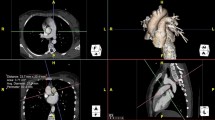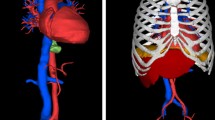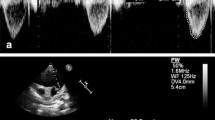Abstract
Recent advances in available percutaneous device technology require accurate measurements and quantification of relationships between right ventricular outflow tract (RVOT) structures in children with and without congenital heart disease to determine device suitability. To date, no population study has described normal reference ranges of these measurements by computed tomography (CT). We aimed to establish normative values for four CT-derived measurements between RVOT structures from a heterogeneous population without heart disease and develop z scores useful for clinical practice. Patients without heart disease who underwent cardiac CT between April 2014 and February 2021 at Children’s Hospital Colorado were included. Distance between the right ventricular (RV) apex to pulmonary valve (PV), PV to pulmonary trunk bifurcation, and bifurcation to the right and left pulmonary artery was measured. Previously validated models were used to normalize the measurements and calculate Z scores. Each measurement was plotted against BSA and Z scores distributions were used as reference lines. Three-hundred and sixty-four healthy patients with a mean age of 8.8 years (range 1–21), 58% male, and BSA of 1 m2 (range 0.4–2.1) were analyzed. The Haycock formula was used to present data as predicted values for a given BSA and within equations relating each measurement to BSA. Predicted values and Z-score boundaries for all measurements are presented.We report CT-derived normative data for four measurements between RVOT structures from a heterogeneous cohort of healthy children. Knowledge of this normative data will be useful in both determining device fit and customizing future devices to accommodate the diverse pediatric size range.


Similar content being viewed by others
Abbreviations
- BiVAD:
-
Biventricular assist device
- BSA:
-
Body surface area
- CT:
-
Computed tomography
- LPA:
-
Left pulmonary artery
- PT:
-
Pulmonary trunk
- PV:
-
Pulmonary valve
- RPA:
-
Right pulmonary artery
- RV:
-
Right ventricle
- RVOT:
-
Right ventricular outflow tract
- SD:
-
Standard deviation
- VAD:
-
Ventricular assist device
References
Knobel Z, Kellenberger CJ, Kaiser T, Albisetti M, Bergsträsser E, Valsangiacomo Buechel ER (2011) Geometry and dimensions of the pulmonary artery bifurcation in children and adolescents: assessment in vivo by contrast-enhanced MR-angiography. Int J Cardiovasc Imaging 27(3):385–396
Gutgesell HP, French M (1991) Echocardiographic determination of aortic and pulmonary valve areas in subjects with normal hearts. Am J Cardiol 68(8):773–776
Pettersen MD, Du W, Skeens ME, Humes RA (2008) Regression equations for calculation of z scores of cardiac structures in a large cohort of healthy infants, children, and adolescents: an echocardiographic study. J Am Soc Echocardiogr 21(8):922–934
Snider AR, Enderlein MA, Teitel DF, Juster RP (1984) Two-dimensional echocardiographic determination of aortic and pulmonary artery sizes from infancy to adulthood in normal subjects. Am J Cardiol 53(1):218–224
VanderPluym CJ, Fynn-Thompson F, Blume ED (2014) Ventricular assist devices in children. Circulation 129(14):1530–1537
Baez Hernandez N, Kirk R, Sutcliffe D, Davies R, Jaquiss R, Gao A et al (2020) Utilization and outcomes in biventricular assist device support in pediatrics. J Thorac Cardiovasc Surg 160(5):1301–8.e2
Morgan GJ, Sadeghi S, Salem MM, Wilson N, Kay J, Rothman A et al (2019) SAPIEN valve for percutaneous transcatheter pulmonary valve replacement without “pre-stenting”: a multi-institutional experience. Catheter Cardiovasc Interv 93(2):324–329
Alkashkari W, Albugami S, Abbadi M, Niyazi A, Alsubei A, Hijazi ZM (2020) Transcatheter pulmonary valve replacement in pediatric patients. Expert Rev Med Devices 17(6):541–554
Holzer RJ, Hijazi ZM (2016) Transcatheter pulmonary valve replacement: State of the art. Catheter Cardiovasc Interv 87(1):117–128
Chung R, Taylor AM (2014) Imaging for preintervention planning: transcatheter pulmonary valve therapy. Circ Cardiovasc Imaging 7(1):182–189
Curran L, Agrawal H, Kallianos K, Kheiwa A, Lin S, Ordovas K et al (2020) Computed tomography guided sizing for transcatheter pulmonary valve replacement. Int J Cardiol Heart Vasc 29:100523
Revels JW, Wang SS, Gharai LR, Febbo J, Fadl S, Bastawrous S (2021) The role of CT in planning percutaneous structural heart interventions: Where to measure and why. Clin Imaging 76:247–264
Sun X, Hao Y, Sebastian Kiekenap JF, Emeis J, Steitz M, Breitenstein-Attach A et al (2022) Four-dimensional computed tomography-guided valve sizing for transcatheter pulmonary valve replacement. J Vis Exp. https://doi.org/10.3791/63367
Schievano S, Coats L, Migliavacca F, Norman W, Frigiola A, Deanfield J et al (2007) Variations in right ventricular outflow tract morphology following repair of congenital heart disease: implications for percutaneous pulmonary valve implantation. J Cardiovasc Magn Reson 9(4):687–695
Lasa JJ, Castellanos DA, Denfield SW, Dreyer WJ, Tume SC, Justino H et al (2018) First report of biventricular percutaneous impella ventricular assist device use in pediatric patients. Asaio J 64(5):e134–e137
Qureshi AM, Turner ME, O’Neill W, Denfield SW, Aghili N, Badiye A et al (2020) Percutaneous Impella RP use for refractory right heart failure in adolescents and young adults-a multicenter US experience. Catheter Cardiovasc Interv 96(2):376–81
Zilberman MV, Khoury PR, Kimball RT (2005) Two-dimensional echocardiographic valve measurements in healthy children: gender-specific differences. Pediatr Cardiol 26(4):356–360
Lu MT, Cai T, Ersoy H, Whitmore AG, Levit NA, Goldhaber SZ, Rybicki FJ (2009) Comparison of ECG-gated versus non-gated CT ventricular measurements in thirty patients with acute pulmonary embolism. Int J Cardiovasc Imaging 25(1):101–107. https://doi.org/10.1007/s10554-008-9342-0
Acknowledgements
None.
Author information
Authors and Affiliations
Contributions
JZ, MM and GM conceived the idea of developing normative values between RVOT structures. JS was responsible for data collection. NS and SR conducted the data analysis. NS wrote the manuscript in discussion with JZ. GM and JZ revised the manuscript for quality. All authors contributed to the article and approved the submitted version.
Corresponding author
Ethics declarations
Competing interest
The authors have no relevant financial or non-financial interests to disclose.
Ethical Approval
This retrospective chart review study involving human participants was in accordance with the ethical standards of the institutional and national research committee and with the 1964 Helsinki Declaration and its later amendments or comparable ethical standards. The Human Investigation Committee (IRB) of the Children’s Hospital Colorado approved this study.
Additional information
Publisher's Note
Springer Nature remains neutral with regard to jurisdictional claims in published maps and institutional affiliations.
Supplementary Information
Below is the link to the electronic supplementary material.
Rights and permissions
Springer Nature or its licensor (e.g. a society or other partner) holds exclusive rights to this article under a publishing agreement with the author(s) or other rightsholder(s); author self-archiving of the accepted manuscript version of this article is solely governed by the terms of such publishing agreement and applicable law.
About this article
Cite this article
Soszyn, N., Schweigert, J., Franco, S.R. et al. Computed Tomography-Derived Normative Values of Right Ventricular Outflow Tract Structures in the Pediatric Population. Pediatr Cardiol (2024). https://doi.org/10.1007/s00246-024-03456-2
Received:
Accepted:
Published:
DOI: https://doi.org/10.1007/s00246-024-03456-2




